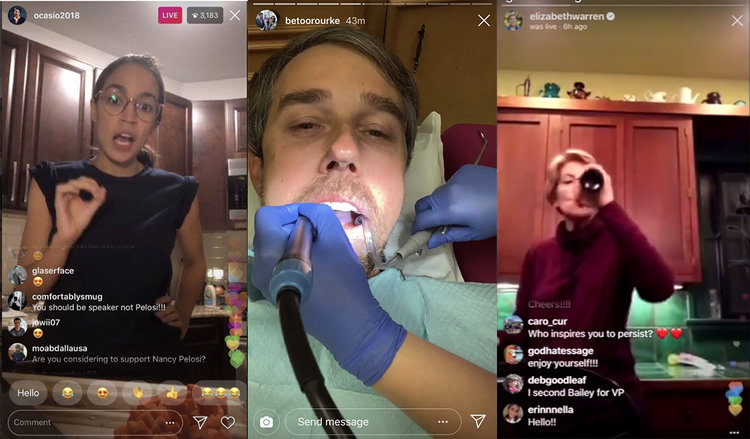Out-of-home advertising (OOH) — also known as outdoor media — is the marketing you see…
Content Delivery in 2020 Politics: Live, Live, Live!
In an era when too much never seems to be enough, especially where politics is concerned, it seemed somewhat surprising when former Texas congressman Beto O’Rourke caught flak for live-streaming his dental appointment on Instagram this month.
“God I hope Beto O’Rourke doesn’t need a colonoscopy anytime soon,” tweeted Ben Jacobs, a political reporter for The Guardian.
After all, O’Rourke — who was quizzing his hygienist about her family’s Mexican background — has road-tripped and cooked a steak dinner live on Instagram after his Senate defeat to Ted Cruz. New Congressional freshman Alexandria Ocasio-Cortez (D-NY) has also baked and danced online while answering questions about how Washington works (and responding to social media trolls).
Political hopeful Sen. Kamala D. Harris (D-Calif.) shared her Thanksgiving turkey, and Sen. Elizabeth Warren (D-MA) awkwardly grabbed a Michelob Ultra and introduced her husband while live Instagramming from her Massachusetts home. And then there was the Republican candidate who live-streamed herself challenging a transgender woman for using a public women’s restroom in Los Angeles.
Make no mistake: The 2020 presidential campaign, already kicking into gear, will take place in an unprecedented media and engagement marketing environment of in-your-face, unfiltered (and often cringe-worthy) immediacy. Political live-streaming as a communication tool could not only bestow authenticity to an otherwise stale and scripted primary process, but it may also result in digital-savvy candidates vaulting over everyone else.
Think Comedians in Cars Getting Coffee, only with people who want to be the Leader of the Free World, poor lighting, and fewer laughs.
the future of candidate marketing
“It’s not going to be like anything we have seen before,” a Democratic strategist preparing a 2020 campaign told Washington Post reporter Michael Scherer, on the condition of anonymity. “The digital front-runner is going to win the nomination. That goes to both fundraising and it goes to content delivery.”
Live-streaming technology has been around since the 1990s, capturing both precious animals and violent deaths alike. But it took off in recent years with one of the most acrimonious elections in US history and as millions of Americans cut their cable cords.
Everything from the political conventions to former FBI Director James Comey’s testimony were live-streamed on mobile apps as well as YouTube, Direct TV, Twitch, Bing, Twitter and Facebook, among other sites. Several cities, including New York City, actually passed bylaws requiring local governments to start streaming city council meetings. These days, the city of Austin, Texas, reportedly streams more than 3,000 video clips to its residents each month.
The upswing is unlikely to slow, with new live-streaming services launching this year from AT&T, Amazon/IMDb, Apple, Facebook, DC Entertainment, and Disney, among others. And politicians would be foolish to ignore it.
the numbers don’t lie
The live video streaming market is estimated to grow from $30.29 billion in 2016 to more than $70 billion by 2021.
Internet audiences are viewing more live content than ever before—81% viewed more in 2016 than they did in 2015.
63% of millennials have watched live content and 42% have created it, making this group of young voters the largest consumers and creators of live video.
48,284 viewers watched the US Department of the Interior’s Livestream in 2017, and 388 government organizations across 70 countries used Livestream to broadcast 10,597 events.
a native medium for millennials
With millions of social media followers, many of today’s politicians — including 20 Congressional millennial newcomers — know how to use to circumvent party machinery and cable networks to create a brand experience. It’s second nature for them to directly engage with constituents.
Since winning her race, Ocasio-Cortez has recorded and posted everything from caucus orientation rooms to walking the streets of Capitol Hill. Meanwhile, O’Rourke walked through a calm El Paso in the dark to counter Drumpf’s argument that border areas are lawless.
Thousands of Bernie Sanders supporters recently gathered at more than 400 live-streamed events nationwide to encourage the Vermont senator (a millennial favorite) to run for president in 2020. Just days earlier, Sanders had live-streamed his response to Drumpf’s prime time Oval Office address on the government shutdown and border security.
At the same time, trumptube.tv provides everything Donald, from live-streamed videos to rallies (including music playlists) and live-time tweets.
“The age of television rewarded the skill of capturing an audience from a podium,” Derek Thompson recently wrote in The Atlantic. “But politicians who thrive on social media will have to master a different suite of skills, such as mimicking the internet’s more naturalistic, self-aware style in a medium where the distance between star and viewer is closed, and where all viewers are conscious of themselves as a collective audience.”
He went on to ask the Million Dollar Question, “Is instagram politics good for democracy? Who knows.”




